+ Open data
Open data
- Basic information
Basic information
| Entry | Database: PDB / ID: 8uyp | ||||||||||||||||||||||||||||||||||||
|---|---|---|---|---|---|---|---|---|---|---|---|---|---|---|---|---|---|---|---|---|---|---|---|---|---|---|---|---|---|---|---|---|---|---|---|---|---|
| Title | SARS-CoV-1 5' proximal stem-loop 5 | ||||||||||||||||||||||||||||||||||||
 Components Components | SARS-CoV-1 5' proximal stem-loop 5 | ||||||||||||||||||||||||||||||||||||
 Keywords Keywords |  RNA / SL5 / RNA / SL5 /  coronavirus / coronavirus /  5' UTR 5' UTR | ||||||||||||||||||||||||||||||||||||
| Function / homology |  : / : /  RNA / RNA (> 10) / RNA (> 100) RNA / RNA (> 10) / RNA (> 100) Function and homology information Function and homology information | ||||||||||||||||||||||||||||||||||||
| Biological species |   SARS coronavirus Tor2 SARS coronavirus Tor2 | ||||||||||||||||||||||||||||||||||||
| Method |  ELECTRON MICROSCOPY / ELECTRON MICROSCOPY /  single particle reconstruction / single particle reconstruction /  cryo EM / Resolution: 7.1 Å cryo EM / Resolution: 7.1 Å | ||||||||||||||||||||||||||||||||||||
 Authors Authors | Kretsch, R.C. / Xu, L. / Zheludev, I.N. / Zhou, X. / Huang, R. / Nye, G. / Li, S. / Zhang, K. / Chiu, W. / Das, R. | ||||||||||||||||||||||||||||||||||||
| Funding support |  United States, United States,  China, 11items China, 11items
| ||||||||||||||||||||||||||||||||||||
 Citation Citation |  Journal: Proc Natl Acad Sci U S A / Year: 2024 Journal: Proc Natl Acad Sci U S A / Year: 2024Title: Tertiary folds of the SL5 RNA from the 5' proximal region of SARS-CoV-2 and related coronaviruses. Authors: Rachael C Kretsch / Lily Xu / Ivan N Zheludev / Xueting Zhou / Rui Huang / Grace Nye / Shanshan Li / Kaiming Zhang / Wah Chiu / Rhiju Das /   Abstract: Coronavirus genomes sequester their start codons within stem-loop 5 (SL5), a structured, 5' genomic RNA element. In most alpha- and betacoronaviruses, the secondary structure of SL5 is predicted to ...Coronavirus genomes sequester their start codons within stem-loop 5 (SL5), a structured, 5' genomic RNA element. In most alpha- and betacoronaviruses, the secondary structure of SL5 is predicted to contain a four-way junction of helical stems, some of which are capped with UUYYGU hexaloops. Here, using cryogenic electron microscopy (cryo-EM) and computational modeling with biochemically determined secondary structures, we present three-dimensional structures of SL5 from six coronaviruses. The SL5 domain of betacoronavirus severe-acute-respiratory-syndrome-related coronavirus 2 (SARS-CoV-2), resolved at 4.7 Å resolution, exhibits a T-shaped structure, with its UUYYGU hexaloops at opposing ends of a coaxial stack, the T's "arms." Further analysis of SL5 domains from SARS-CoV-1 and MERS (7.1 and 6.4 to 6.9 Å resolution, respectively) indicate that the junction geometry and inter-hexaloop distances are conserved features across these human-infecting betacoronaviruses. The MERS SL5 domain displays an additional tertiary interaction, which is also observed in the non-human-infecting betacoronavirus BtCoV-HKU5 (5.9 to 8.0 Å resolution). SL5s from human-infecting alphacoronaviruses, HCoV-229E and HCoV-NL63 (6.5 and 8.4 to 9.0 Å resolution, respectively), exhibit the same coaxial stacks, including the UUYYGU-capped arms, but with a phylogenetically distinct crossing angle, an X-shape. As such, all SL5 domains studied herein fold into stable tertiary structures with cross-genus similarities and notable differences, with implications for potential protein-binding modes and therapeutic targets. #1:  Journal: bioRxiv / Year: 2023 Journal: bioRxiv / Year: 2023Title: Tertiary folds of the SL5 RNA from the 5' proximal region of SARS-CoV-2 and related coronaviruses. Authors: Rachael C Kretsch / Lily Xu / Ivan N Zheludev / Xueting Zhou / Rui Huang / Grace Nye / Shanshan Li / Kaiming Zhang / Wah Chiu / Rhiju Das /   Abstract: Coronavirus genomes sequester their start codons within stem-loop 5 (SL5), a structured, 5' genomic RNA element. In most alpha- and betacoronaviruses, the secondary structure of SL5 is predicted to ...Coronavirus genomes sequester their start codons within stem-loop 5 (SL5), a structured, 5' genomic RNA element. In most alpha- and betacoronaviruses, the secondary structure of SL5 is predicted to contain a four-way junction of helical stems, some of which are capped with UUYYGU hexaloops. Here, using cryogenic electron microscopy (cryo-EM) and computational modeling with biochemically-determined secondary structures, we present three-dimensional structures of SL5 from six coronaviruses. The SL5 domain of betacoronavirus SARS-CoV-2, resolved at 4.7 Å resolution, exhibits a T-shaped structure, with its UUYYGU hexaloops at opposing ends of a coaxial stack, the T's "arms." Further analysis of SL5 domains from SARS-CoV-1 and MERS (7.1 and 6.4-6.9 Å resolution, respectively) indicate that the junction geometry and inter-hexaloop distances are conserved features across the studied human-infecting betacoronaviruses. The MERS SL5 domain displays an additional tertiary interaction, which is also observed in the non-human-infecting betacoronavirus BtCoV-HKU5 (5.9-8.0 Å resolution). SL5s from human-infecting alphacoronaviruses, HCoV-229E and HCoV-NL63 (6.5 and 8.4-9.0 Å resolution, respectively), exhibit the same coaxial stacks, including the UUYYGU-capped arms, but with a phylogenetically distinct crossing angle, an X-shape. As such, all SL5 domains studied herein fold into stable tertiary structures with cross-genus similarities, with implications for potential protein-binding modes and therapeutic targets. | ||||||||||||||||||||||||||||||||||||
| History |
|
- Structure visualization
Structure visualization
| Structure viewer | Molecule:  Molmil Molmil Jmol/JSmol Jmol/JSmol |
|---|
- Downloads & links
Downloads & links
- Download
Download
| PDBx/mmCIF format |  8uyp.cif.gz 8uyp.cif.gz | 1.9 MB | Display |  PDBx/mmCIF format PDBx/mmCIF format |
|---|---|---|---|---|
| PDB format |  pdb8uyp.ent.gz pdb8uyp.ent.gz | 1.6 MB | Display |  PDB format PDB format |
| PDBx/mmJSON format |  8uyp.json.gz 8uyp.json.gz | Tree view |  PDBx/mmJSON format PDBx/mmJSON format | |
| Others |  Other downloads Other downloads |
-Validation report
| Arichive directory |  https://data.pdbj.org/pub/pdb/validation_reports/uy/8uyp https://data.pdbj.org/pub/pdb/validation_reports/uy/8uyp ftp://data.pdbj.org/pub/pdb/validation_reports/uy/8uyp ftp://data.pdbj.org/pub/pdb/validation_reports/uy/8uyp | HTTPS FTP |
|---|
-Related structure data
| Related structure data |  42816MC 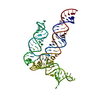 8uyeC 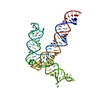 8uygC 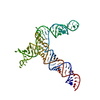 8uyjC 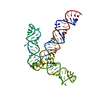 8uykC 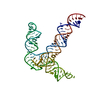 8uylC 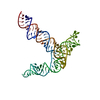 8uymC 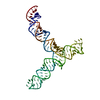 8uysC C: citing same article ( M: map data used to model this data |
|---|---|
| Similar structure data | Similarity search - Function & homology  F&H Search F&H Search |
- Links
Links
- Assembly
Assembly
| Deposited unit | 
|
|---|---|
| 1 |
|
| Number of models | 8 |
- Components
Components
| #1: RNA chain | Mass: 45917.074 Da / Num. of mol.: 1 / Source method: obtained synthetically / Source: (synth.)   SARS coronavirus Tor2 / References: GenBank: NC_004718.3 SARS coronavirus Tor2 / References: GenBank: NC_004718.3 |
|---|
-Experimental details
-Experiment
| Experiment | Method:  ELECTRON MICROSCOPY ELECTRON MICROSCOPY |
|---|---|
| EM experiment | Aggregation state: PARTICLE / 3D reconstruction method:  single particle reconstruction single particle reconstruction |
- Sample preparation
Sample preparation
| Component | Name: SARS-CoV-1 5' proximal stem-loop 5 / Type: COMPLEX / Entity ID: all / Source: SYNTHETIC | |||||||||||||||
|---|---|---|---|---|---|---|---|---|---|---|---|---|---|---|---|---|
| Molecular weight | Value: 0.04614 MDa / Experimental value: NO | |||||||||||||||
| Buffer solution | pH: 8 | |||||||||||||||
| Buffer component |
| |||||||||||||||
| Specimen | Conc.: 1.38 mg/ml / Embedding applied: NO / Shadowing applied: NO / Staining applied : NO / Vitrification applied : NO / Vitrification applied : YES : YES | |||||||||||||||
| Specimen support | Grid material: COPPER / Grid mesh size: 300 divisions/in. / Grid type: Quantifoil R1.2/1.3 | |||||||||||||||
Vitrification | Instrument: FEI VITROBOT MARK IV / Cryogen name: ETHANE / Humidity: 100 % / Chamber temperature: 278 K |
- Electron microscopy imaging
Electron microscopy imaging
| Experimental equipment |  Model: Titan Krios / Image courtesy: FEI Company |
|---|---|
| Microscopy | Model: TFS KRIOS |
| Electron gun | Electron source : :  FIELD EMISSION GUN / Accelerating voltage: 300 kV / Illumination mode: FLOOD BEAM FIELD EMISSION GUN / Accelerating voltage: 300 kV / Illumination mode: FLOOD BEAM |
| Electron lens | Mode: BRIGHT FIELD Bright-field microscopy / Nominal magnification: 105000 X / Nominal defocus max: 2000 nm / Nominal defocus min: 1000 nm / Cs Bright-field microscopy / Nominal magnification: 105000 X / Nominal defocus max: 2000 nm / Nominal defocus min: 1000 nm / Cs : 2.7 mm / C2 aperture diameter: 70 µm / Alignment procedure: COMA FREE : 2.7 mm / C2 aperture diameter: 70 µm / Alignment procedure: COMA FREE |
| Specimen holder | Cryogen: NITROGEN / Specimen holder model: FEI TITAN KRIOS AUTOGRID HOLDER |
| Image recording | Average exposure time: 0.59 sec. / Electron dose: 50 e/Å2 / Film or detector model: GATAN K3 (6k x 4k) / Num. of grids imaged: 1 / Num. of real images: 10376 |
| Image scans | Width: 5760 / Height: 4092 |
- Processing
Processing
| EM software |
| ||||||||||||||||||||||||||||||||||||||||||||||||||
|---|---|---|---|---|---|---|---|---|---|---|---|---|---|---|---|---|---|---|---|---|---|---|---|---|---|---|---|---|---|---|---|---|---|---|---|---|---|---|---|---|---|---|---|---|---|---|---|---|---|---|---|
CTF correction | Type: PHASE FLIPPING AND AMPLITUDE CORRECTION | ||||||||||||||||||||||||||||||||||||||||||||||||||
| Particle selection | Num. of particles selected: 1734565 | ||||||||||||||||||||||||||||||||||||||||||||||||||
| Symmetry | Point symmetry : C1 (asymmetric) : C1 (asymmetric) | ||||||||||||||||||||||||||||||||||||||||||||||||||
3D reconstruction | Resolution: 7.1 Å / Resolution method: FSC 0.143 CUT-OFF / Num. of particles: 220917 / Algorithm: FOURIER SPACE / Num. of class averages: 1 / Symmetry type: POINT | ||||||||||||||||||||||||||||||||||||||||||||||||||
| Atomic model building | Protocol: OTHER / Space: REAL |
 Movie
Movie Controller
Controller

















 PDBj
PDBj





























